![]()
![]()
![]()
Use LEFT and RIGHT arrow keys to navigate between flashcards;
Use UP and DOWN arrow keys to flip the card;
H to show hint;
A reads text to speech;
25 Cards in this Set
- Front
- Back
|
Na+ channels
|
Voltage gated @ axon,
Mechanical (ligand) @ dendrites |
|
|
K+ channels
|
Voltage gated
|
|
|
Ca++ Channels
|
Voltage gated @ axon terminals
|
|
|
Cl-
|
Chemically gated
|
|
|
Nernst Equation
|
Eq(ion) = 61/z log[ion(out)/ion(in)]
|
|
|
Gate types
|
*Voltage
* ligand-gated (extracellular/Intracellular ligand) *Mechanically gated |
|
|
Graded and Action Potential comparison
|
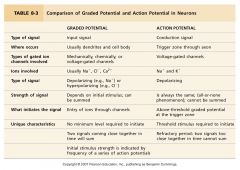
|
|
|
Action Potential
|
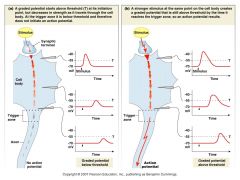
|
|
|
Action Potential Complete graph,
Memorize the YELLOW Na Violet K+ |
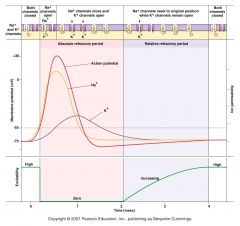
|
|
|
AP inactivation, Absolute refractory period.
INFLOW of Na ions. |

|
|
|
Myelin Sheath
Nodes of ranvier Saltatory Conduction |
it’s a lipid, that surrounds. It acts as an insulator
*Farther the myelination (bigger nodes of ranvier) the faster the transmission of action potential. Jump down axons as Na+ channels are in nodes. |
|
|
Inactivation property
|
Property that is responsible for one way direction is
|
|
|
Graded potentials (Additional info)
|
can BOTH depolarize or hyperpolarize the cell
found in dendrite and axon The way the neuron works is that what you want is graded potentials coming all over the dendritic bodies and adding up to the axon and eventually being able to meet the threshold in the axon hillock. |
|
|
Excitation Secretion couploing
|
the conversion of electrical signal to chemical (and back again).
If Ca enters hte pre synaptic terminal, it will depolarize the terminal and cause AP. It will then stimulate NT vesicles to migrate down the synapse and perform excitatosis to release NT in synapse. |
|
|
(Excitation-Secretion Coupling)
Neurocrines: 7 major classes: |
1. acetylcholine
2. amines 3. amino acids 4. purines (ATP, AMP) 5. gases (NO 6. peptides 7. lipids (eicosanoids cannabinoid R) |
|
|
Major Neurcrines
1. Acetylcholine (ACh) 2. Norephinephrine 3. Dopamine 4. Serotonin 5. Histamine |
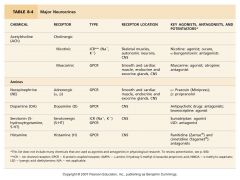
|
|
|
Major Neucrines (part 2)
Amino Acid 1. Glutamate 2. GABA 3. Glycine Purines 4. Adenosine Gases 5. Nitric Oxide (NO) |
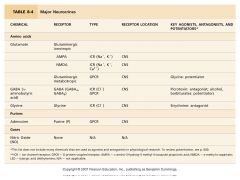
|
|
|
Acetylcholinesterase
|
chops the ACh, then
choline byproduct is transported back into the axon terminal and used to make more ACh. |
|
|
Turning off Synaptic Response
|
1. returned to Axon terminal for reuse, or transported into glial cells.
2. Enzymes inactivation 3. NT can diffuse out of synaptic cleft |
|
|
Action potential (Stimulus strength)
|
converted to FREQUENCY, the bigger the stimulus strength, the more trains of Action potential will occur,
*But all with same amplitude, just different in number |
|
|
Type of NT receptor dictates creation of EPSP or IPSP
Ca2+ Cl- (from GABA) |
- Ca2+ = exocytosis of synaptic vesicle -
-Cl- = hyperpolarizes the cell, making it harder to activate. |
|
|
Ionotropic –
metabotrophic -- |
=when ions channels open., fast, short lived
= Triggers a secondary response inside the cell. Slow, but usually long life. |
|
|
Divergent pathways
Convergent pathways |
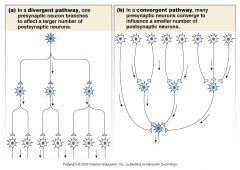
|
|
|
Integration = neuron to neuron
communication Pre synaptic Post Synaptic |
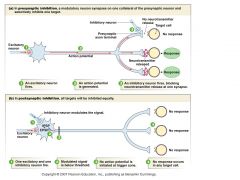
|
|
|
Synaptic Plasticity
NMDA-R & hippocampus |
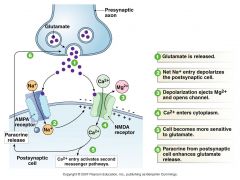
critical to memory
and learning in hippocampus #6 Is paracrine regulation |

